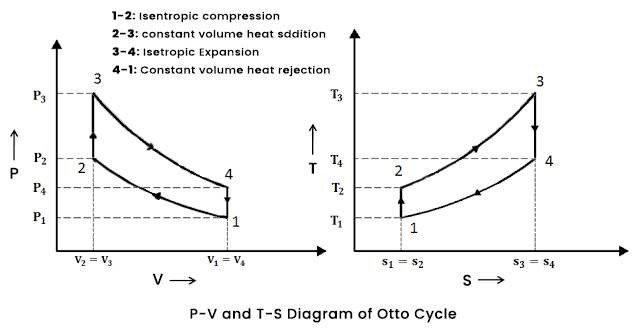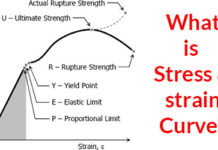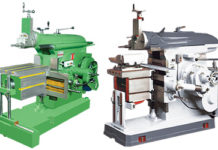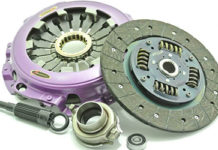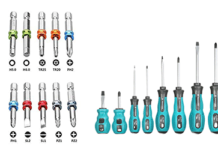Contents

Otto Cycle
Otto cycle was first introduced by Dr. Nikolaus August Otto. The Otto cycle has a power cycle which is used for the spark-ignition engine. Today the entire modern petrol engine works on the Otto cycle. There are four processes in the Otto Cycle which are two isentropic (reversible adiabatic) processes and two isochoric (constant volume) processes. And has a low compression ratio ranges from 7:1 to 10:1. Here we understand what is otto cycle T-S diagram and otto cycle P-V diagram.
There are four processes in the cycle:
- Isentropic (reversible adiabatic) compression
- Constant volume (Isochoric) heat addition
- Isentropic (reversible adiabatic) Expansion
- Constant volume of heat rejection.
Before explaining these processes first understand what is an isentropic and isochoric process.
The Isentropic Process is a thermodynamic process where the entropy of the system remains unchanged. The entropy remains constant. There is no heat dissipation that takes place in the Isentropic process. This is also known as a reversible adiabatic process.
The Isochoric Process is where the process takes place at constant volume.
Read Also: How does a Carburetor Work?What is Otto Cycle and how it works?
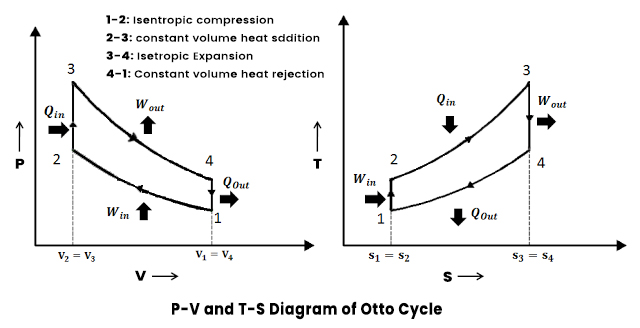
Process 1-2: Isentropic Compression
In this process, the motion of the piston is from TDC to BDC. Air sucked into the cylinder while suction stroke undergoes reversible adiabatic (isentropic) compression. As the air is compressed, the pressure increases from P1 to P2 and the volume decreases from V1 to V2. The temperature rises from T1 to T2 and entropy remains constant.
Process 2-3: Constant Volume Heat Addition
This is the isochoric process where the heat is added to the air at constant volume. The piston is rest for a moment at TDC and during this, the time heat is added to the air through an external source. As the heat is added, the pressure increases from P2 to P3, pressure, volume remains constant (V2=V3) and the temperature increases from T2 to T3 and the entropy increases from S2 to S3.
![]()
Process 3-4: Isentropic Expansion
Here the Isentropic (reversible adiabatic) expansion of air takes place. The piston moves from TDC to BDC. As in this process, there is an expansion of air, the pressure decreases from P3 to P4 and volume increases from V3 to V4 and temperature falls from T3 to T4. The entropy remains unchanged.
Constant Volume Heat Rejection
The piston rest for a moment a BDC and rejection of heat take place at constant volume. The pressure decreases from P4 to P1 and Volume remains constant (V4=V1) and the temperature falls from T4 to T1.
The amount of heat rejected in this process is
![]()
If this cycle is used in the four-stroke petrol engine than two process increases. One is suction of air-fuel mixture inside the cylinder which takes place at constant atmospheric pressure and the other is the exhaust of gases out of engine cylinder at constant atmospheric pressure. The two above discussed processes are not shown in the ideal Otto cycle.
| S.no | Process | Operation | Position of piston | Change in parameter |
| 1. | 1-2: Isentropic Compression | Compression of air. | BDC to TDC | V: Decreases from V1 To V2
T: Increases from T1 to T2 P: Increases from P1 to P2 S: Entropy remains constant (S1=S2) |
| 2. | 2-3: Constant Volume Heat Addition | Heat is added in the form of spark and combustion occurs. | At TDC for a moment | V: Remains constant (V2 = V3 )
T: Increases from T2 to T3 P: Increases from P2 S: Increases from S2 to S3 |
| 3. | 3-4: Isentropic Expansion | The expansion of air takes place due to heat addition. | TDC to BDC | V: Increases from V3 to V4
T: Decreases from T3 to T4 P: Decreases from P3 to P4 S: Entropy remains constant (S3=S4) |
| 4. | 4-1: Constant Volume Heat Rejection | Heat is rejected to a sink. | At BDC for a moment | V: Volume remains constant(V4 = V1 )
T: Decreases from T4 to T1 P: Decreases from P4 to P1 S: Decreases from S4 to S1 |
How to calculate Thermal Efficiency?
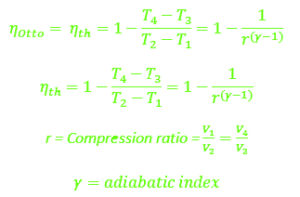
Application of Otto Cycle
Otto Cycle is used in all two-stroke and four-stroke petrol engines of motorcycles, cars and in other light-duty vehicles.
This is the information about the Otto Cycle and Otto Cycle T-S diagram and Otto Cycle P-V diagram.
🔔We hope this information will help you. For more new information click on the notification button and get regular updates from Unbox Factory.
Now if you find this information helpful, share it with your friends, family, and colleagues.
If you like this post, let us know by comment below, if you want to add-on information about this topic, comment the information. We will consider the information if it is relevant.
Thank you for reading.

